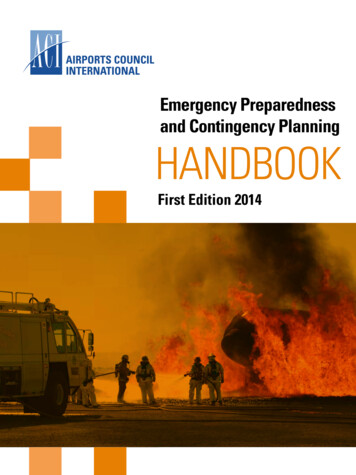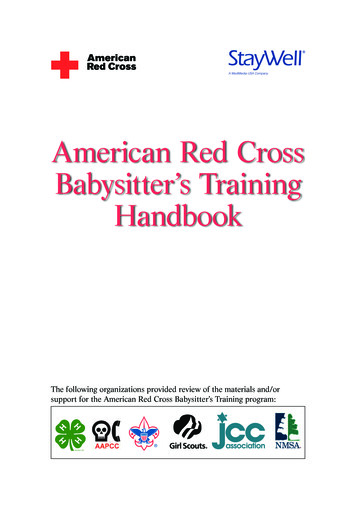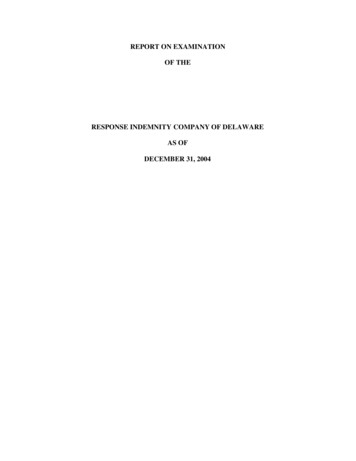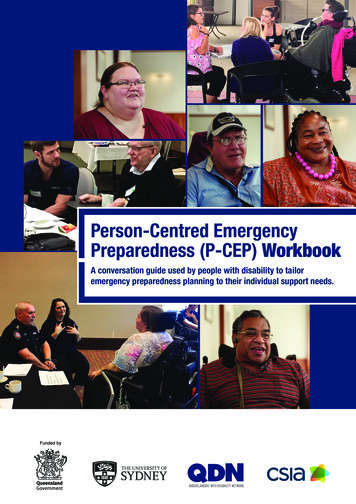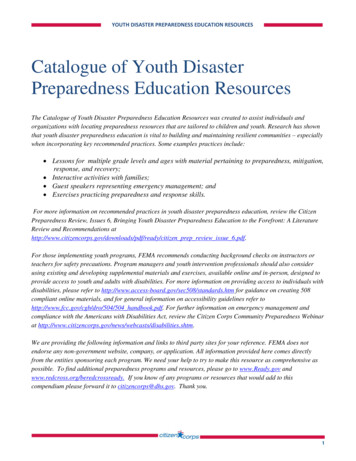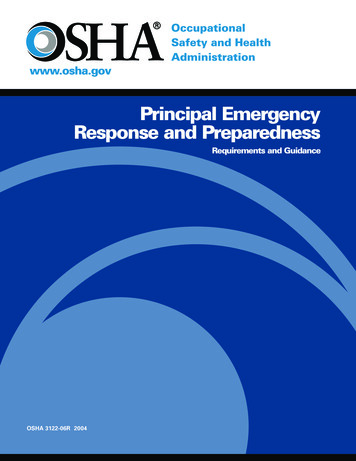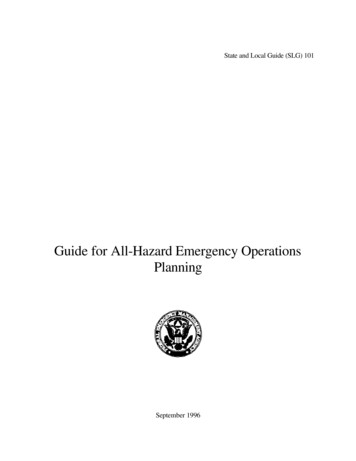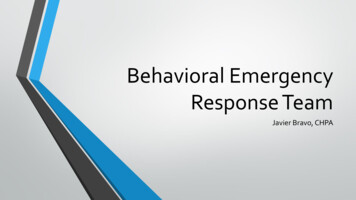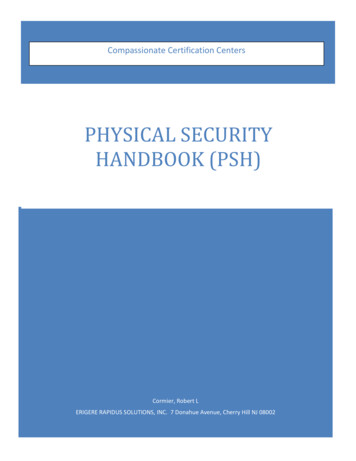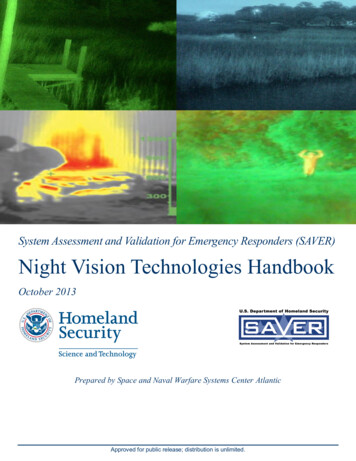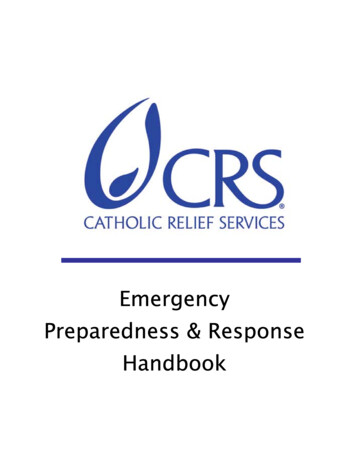
Transcription
EmergencyPreparedness & ResponseHandbook
AcknowledgementsPublished by Catholic Relief Services, November 2002.Program Quality and Support DepartmentCatholic Relief Services209 W. Fayette St.Baltimore, MD 21201-3443U.S.A.These guidelines are a product of the CRS Emergency Response Team (ERT), a unit of theProgram Quality and Support Department (PQSD). Annemarie Reilly is the primary author.Jenny Aker contributed to the section on conceptual frameworks and food security. Much ofthe information related to disaster prevention, mitigation and preparedness is borroweddirectly or adapted from the CRS Mitigation Handbook (Kristen Hicks, 1996). Theinformation regarding contingency planning is adapted from the United Nations’Contingency Planning: A Practical Guide for Field Staff (Complex Emergencies TrainingInitiative-CETI, 1996).PQSD and ERT members contributed to the content and reviewed all drafts. Drafts were alsopeer reviewed by CRS staff representing both headquarters and field offices. A specialthanks to all who contributed to this handbook.
AcronymsBPRMDOS Bureau of Population, Refugees and MigrationCICaritas InternationalisCREDCentre for Research on the Epidemiology of DisastersDOSUS Department of StateCRDFIDCountry RepresentativeUK Department for International DevelopmentECHOEuropean Community Humanitarian OfficeEMTExecutive Management TeamERTERWGEmergency Response TeamEmergency Response Working GroupFFP/ERUSAID Food for Peace/Emergency ResponseHQHeadquarters—CRS/BaltimoreHRHuman ResourcesICRC/IFRCInternational Committee of the Red Cross/Red Crescent/InternationalIDPInternally Displaced PersonFederation of the Red Cross/Red Crescent SocietiesIFADInternational Fund for Agriculture DevelopmentNGONon-governmental OrganizationOCHAUN Office of Coordination for Humanitarian AffairsOFDAUSAID Office of Foreign Disaster AssistanceOTIUSAID Office of Transition InitiativesSHARPCRS Strategic Humanitarian Action PlanTAPTransition Activities ProgramOSDRDSFPOverseas Support DepartmentRegional DirectorSupplementary Feeding ProgramTDYTemporary DutyTFPTherapeutic Feeding ProgramUSDAUnited States Department of AgricultureUSAIDUNHCRWFPWHOUnited States Agency for International DevelopmentUnited Nations High Commissioner for RefugeesWorld Food ProgrammeWorld Health Organization
Table of ContentsIntroductionSection 1: Foundations of CRS Emergency Preparedness & Response1.1 The CRS Emergency Preparedness & Response Mission and Vision1.2 Emergency Preparedness & Response: Key Definitions and Concepts1.2.1What is an Emergency?1.2.3Emergency Phases1.2.21.2.4Disaster TypologiesUnderstanding Disaster Prevention, Mitigation and Preparedness1.2.4.1Disaster Prevention1.2.4.3Disaster Preparedness1.2.4.21.2.5Disaster MitigationCross-cutting Themes in Emergency Preparedness & Response1.2.5.1The Rights-based Approach to Humanitarian Action1.2.5.3Do No Harm1.2.5.21.2.5.41.2.5.51.2.5.6The CRS Justice Lens and Peacebuilding in EmergenciesCoordinationCapacity Building and PartnershipTransition Programming1.3 Principle-led ProgrammingSection 2: Emergency Preparedness & Response Program Quality2.1 General Background on CRS Emergency Preparedness & Response2.1.1CRS Emergency Preparedness & Response Program Quality Statements andTechnical Core Competencies2.2 Excellence in Emergency Programming2.2.1Building Blocks for CRS Emergency Program Quality2.2.3Conceptual Frameworks for Emergencies2.2.22.2.42.2.5The Big Picture: The Relief-Development LinkThe Project CycleProject Design2.2.5.1 Assessment2.2.5.2 Goals, Objectives, Indicators2.2.5.3 Targeting and Selection Criteria
2.2.5.4 Implementation2.2.5.5 Monitoring and EvaluationSection 3: CRS Emergency Projects: Funding, Review, Headquarters Support3.1 Funding Sources3.1.1CRS Private Resources3.1.3USAID3.1.23.1.4Caritas Internationalis FederationUS Department of State3.1.5US Embassy Ambassador’s Fund3.1.7ECHO3.1.63.1.83.1.9USDAUnited NationsOther Donors3.2 Project Review and Funding Procedure3.3 HQ Emergency Response Working GroupAnnexesA. CRS Guidelines on Humanitarian Aid in Conflict SituationsB. ICRC/IFRC/NGO Code of ConductC. Sphere Project Humanitarian CharterD. International Law Instruments and Ground Rules for Humanitarian Aid in ConflictSituationsE. CRS Emergency Preparedness & Response Program Quality StatementsF. CRS Emergency Proposal FormatG. Technical Review FormatH. Gap Identification ChartI.J.Caritas Internationalis (CI) Guiding Values, Principles, Working Structures andMechanisms for Response to Major EmergenciesCRS Situation Reporting FormatsK. Emergency Response Team Organizational ChartL. Emergency Response Checklist for ManagersM. Websites for Humanitarian Relief News, Organizations and DonorsBoxesBox 1.1 CRS Mission Statement
Box 1.2 CRS Vision StatementBox 1.3 CRS EPR Vision and Mission StatementsBox 1.4 Crude Mortality RateBox 1.5 MitigationBox 1.6 What is the difference between a Refugee and an IDP?Box 1.7 Supporting Peacebuilding in EmergenciesBox 1.8 Underlying Causes of Conflict: the Economic FactorBox 1.9 Emergency Preparedness and Response Training ProgramsBox 1.10 Additional ResourcesBox 2.1 What is Famine?Box 2.2 Sphere Handbook Analysis StandardsBox 2.3 Food Aid Standard and Key IndicatorsBox 2.4 Criteria for Targeting Different Types of VulnerabilityBox 2.5 Additional ResourcesBox 3.1 NICRATablesTable 1.1 Key Indicators of an Emergency SituationTable 1.2 Characterizations of Disaster EventsTable 1.3 An Approach to Peacebuilding in Violent ConflictsTable 1.4 Analytical Tool for a Principled Approach to Emergency ProgrammingFiguresFigure 1.1 Mitigation Framework for Rapid-Onset DisastersFigure 1.2 Mitigation Framework for Slow-Onset DisastersFigure 2.1 Emergency Response Operational FrameworkFigure 2.2 Building Blocks for CRS Emergency Program QualityFigure 2.3 The Risk Reduction LensFigure 2.4 DFID Sustainable Livelihoods FrameworkFigure 2.5 The Project CycleFigure 2.6 The Emergency Project CycleFigure 3.1 Emergency Proposal Review, Recommendation and Funding Procedure for CRSPrivate FundsGlossaryBibliography
Foundations of CRS EmergencyPreparedness & Response1In this section you will find information on the following topics.1.1The CRS Emergency Preparedness and Response Mission andVisionReviews the agency mission and vision statements and the CRS emergencypreparedness and response mission and vision statements.1.2Emergency Preparedness & Response: Key Definitions andConceptsReviews concepts and definitions of emergency, natural and human-madedisasters, complex emergencies, disaster typologies, etc., and discusses thelinkages between disaster prevention, disaster mitigation, disasterpreparedness, emergency response, and development.1.3Principle-led ProgrammingA brief introduction to the principles of emergency work with an emphasis oncore humanitarian principles.
The CRS Mission and Vision1.1The CRS agency mission statement articulates the motivation behind CRS’ work andidentifies the broad ways in which CRS lives out its mission. The statement includes veryclear references to CRS’ work in emergency situations.Box 1.1Catholic Relief ServicesMission StatementCatholic Relief Services was founded in 1943 by the Catholic Bishops of the United States to assistthe poor and disadvantaged outside the country. It is administered by a Board of Bishops selectedby the Episcopal Conference of the United States, and is staffed by men and women committed tothe Catholic Church's apostolate of helping those in need. It maintains strict standards of efficiencyand accountability.The fundamental motivating force in all activities of CRS is the Gospel of Jesus Christ as it pertainsto the alleviation of human suffering, the development of people and the fostering of charity andjustice in the world. The policies and programs of the agency reflect and express the teaching of theCatholic Church. At the same time, Catholic Relief Services assists persons on the basis of need, notcreed, race or nationality.Catholic Relief Services gives active witness to the mandate of Jesus Christ to respond to humanneeds in the following ways: by responding to victims of natural and man-made disasters; by providing assistance to the poor and to alleviate their immediate needs; by supporting self-help programs which involve people and communities in their owdevelopment; by helping those it serves to restore and preserve their dignity and to realize their potential; by collaborating with religious and non-sectarian persons and groups of good will inprograms and projects which contribute to a more equitable society; by helping to educate the people of the United States to fulfill their moral responsibilities inalleviating human suffering, removing its causes, and promoting social justice.In addition to the agency’s mission statement, CRS developed a vision statement in 2001that speaks eloquently to the agency’s vision of the world and provides further support to
our thinking about emergencies. The vision statement calls on CRS staff, partners andsupporters around the world to strive to transform the world in which we live throughsolidarity.Box 1.2Catholic Relief ServicesVision StatementSolidarity will transform the world to: Cherish and uphold the sacredness and dignity of every person;Commit to and practice peace, justice and reconciliation; and,Celebrate and protect the integrity of all creation.CRS Emergency Preparedness & Response Vision and MissionIn December 1999, at the Emergency Preparedness & Response Program Quality Summit inNanyuki, Kenya, a Vision and Mission Statement for CRS emergency preparedness andresponse was developed that reflects the agency’s commitment to justice and to an agencywide approach to emergency programming.Box 1.3CRS Emergency Preparedness and Response VisionCRS promotes social justice, solidarity and compassion through timely emergency preparedness andresponse that addresses the needs of the most vulnerable.CRS Emergency Preparedness & Response MissionCRS fulfills its mission to foster hope for populations in distress when the entire agency: Works together as stakeholders.Shares leadership guided by clear systems and procedures.Builds new and strengthens existing networks of partnerships and relationships.Promotes ownership of emergency response by strengthening local capacities.Achieves quality standards in programming.Accesses human, material and financial resources appropriate to each emergency.
Emergency Preparedness and Response:Key Definitions and Concepts1.21.2.1 What is an Emergency?An emergency according to the Sphere Project: Humanitarian Charter and MinimumStandards in Disaster Response can be defined as “a situation where people’s normal meansof support for life with dignity have failed as a result of natural or human-madecatastrophe.” As promulgated by the United Nations, a disaster is “a serious disruption ofthe functioning of a society, causing widespread human, material or environmental losseswhich exceed the ability of the affected society to cope using only its own resources.” Forthe purposes of this manual, the following definition of emergency, which encompassesboth rapid and slow-onset disasters, will be used:An emergency is an extraordinary situation, present or imminent,in which there are serious and immediate threatsto human life, dignity and livelihoods.As illustrated in the above definition, the word disaster is most often used to refer to acatastrophic event or series of events. The Merriam Webster dictionary defines disaster as“a sudden calamitous event bringing great damage, loss, or destruction.” We would add tothis that a disaster can also be slow-onset such as with droughts. The word emergencymost often refers to the results of such an event or events. The Merriam Webster dictionarydefines emergency as “an unforeseen combination of circumstances or the resulting statethat calls for immediate action [or] an urgent need for assistance or relief.” Even thoughthese words are often used interchangeably, CRS utilizes the emergency definition in thebox above and understands disasters as a catastrophic event or series of events.Another common term referred to in relief work is humanitarian action, which describes theaction that is taken to provide emergency assistance and protection to disaster-affectedpopulations. Assistance and protection are the two pillars of humanitarian action.Sometimes specific humanitarian actions appear to clearly fall under one pillar or another(e.g., protection of unaccompanied children; assistance in the form of providing food aid tofood insecure populations). It is more common, however, that all humanitarian actioncontributes in some way both to protecting and assisting disaster-affected populations fromrisks to their lives and livelihoods.
It is not always clear what constitutes an emergency situation. Not every earthquake orhurricane results in damage to human lives and livelihoods to such an extent that anemergency is declared. In fact, the same weather phenomenon can occur in two differentplaces and have very dissimilar impacts on the lives and livelihoods of those affected. Thiscan be attributed to a wide variety offactors from the population density ofBox 1.4the affected area to the economiccondition of the affected population.Crude Mortality Raterich and poor, yet richer households,One way of defining an emergency is toconstructed homes, for example, haveExcess mortality exists when the crudeDisasters don’t discriminate betweenwith insurance coverage and well-consider changes in mortality and morbidity.more resilient livelihood systems andmortality rate (CMR) is higher than thecan cope with the effects of a disasterbetter than poorer households.So, the question then arises of how CRSdetermines when a disaster eventprevailing mortality level of the surroundingpopulation in an emergency setting.Indeveloping countries a CMR higher than 2deaths per 10,000 persons per day has beenthe traditional definition of excess mortality.requires humanitarian action. A generalThe prevailing mortality rate in developedCenter for Research on the Epidemiologycountries and this needs to be considereddefinition of a disaster, developed by thecountries may vary from that of developingof Disasters (CRED, University ofduring the initial assessment. Calculating theLouvain, Belgium), uses the followingcriteria. 10 or more people reported killed a call for international assistance 100 or more people reported affected declaration of a state of emergencyCMR may not be applicable or relevant to asudden-impact disaster unless there is along-standing or significant populationdisplacement.The Sphere Project: Humanitarian Charter andMinimum Standards in Disaster ResponseHandbookUnfortunately, this kind of academicdefinition doesn’t take into account the various political dynamics that may, for example,lead a government not to declare a state of emergency due to political concerns or,conversely, to request international assistance when it actually has the capacity to respond.Another way of identifying an emergency situation, and one that is closer to what is mostuseful for CRS, is based on the application of key indicators such as the crude mortality ratedescribed in Box 1.4.Measurement of crude mortality rates is a key indicator in major emergencies involvingevents such as epidemic outbreaks or famine. However, emergency situations do not alwaysdevelop dramatically with large scale deaths. For example, an earthquake may not result inany deaths, but may destroy a large percentage of houses leaving the affected population
homeless and vulnerable. Some emergency situations evolve over time and it is harder todetermine when emergency measures should be launched if no baseline data exists tocompare to ongoing monitoring. For this reason, it is critical to be aware of a number of keyindicators to be monitored that will provide clues about the development of an emergencyand trigger points to alert aid agencies on when to intervene.Adapting a table used by UNHCR by including the minimum standards found in the SphereHandbook, Table 1.1 provides emergency indicators that warrant immediate action. TheSphere Handbook makes a significant contribution to humanitarian relief work by providingstandards of response and benchmarks to measure the meeting of those standards. TheSphere Handbook is referred to throughout this document and is available in every CRScountry program office and on the internet (www.sphereproject.org) for further reference.Table 1.1Mortality RateKey Indicators of an Emergency SituationIndicatorEmergency Levels or 1 per 10,000 per dayNutritional Status of Children 10% less than 80% of median weight for heightFood 2,100 calories per person per dayWater Quantity 15 liters per person per day for consumption, cooking, washingWater Quality 25% of people with diarrheaSite Space 30 square meters per personSanitation 20 people per toiletShelter (personal space) 3.5 square meters per personAn important consideration in developing key indicators for emergencies specific to aparticular place is the context. The above indicators were developed primarily with refugeeor displaced populations in camp settings in mind. Many people around the world live inconditions of poverty and destitution in which even some of the minimum standards andkey indicators of emergency response may seem like elusive dreams. These are conditionsof chronic and desperate poverty but are not necessarily classified as “emergencies”. Whatdistinguishes an emergency situation from one in which the population lives in sub-standard conditions is the occurrence of a catastrophic event or events. Situations in whichpeople live in sub-standard conditions require a response on the part of relief anddevelopment organizations but in most cases where a disaster event has not occurred, theresponse should be the longer term work of development rather than emergency response.This is discussed in more detail in the following section.Regardless of how an emergency is defined, CRS must make decisions on whether or not tointervene based on CRS criteria (see Annex A for criteria for a CRS response in conflictsituations). These include key factors such as:
1. The results of thorough assessments and analyses that determine the type and scale ofthe disaster and whether outside assistance is needed to save lives and/or supportlivelihoods.2. An analysis of the value-added of a CRS and/or partner intervention.3. The organizational and technical capacity of the CRS country program and local partnersto intervene.4. Security and safety of CRS and partner staff, program beneficiaries and CRS and partnerproperty (e.g., application of CRS Security and Staff Safety Guidelines; Do No Harmanalysis).5. Funding availability.For CRS, defining an emergency is based first and foremost on the results of assessments.Depending on the scale and urgency of a disaster, assessments can range from rapidsituational assessments to comprehensive sectoral assessments. Regardless of how quicklyan assessment is conducted, there are principles that must be applied to ensure that theinformation collected is accurate and useful. Assessments are briefly discussed in Section 2of this handbook. Additional guidance on assessments will be available in the forthcomingCRS Emergency Assessment Manual.1.2.2 Disaster TypologiesDisasters can be divided into two broad groupings: natural disasters and human-madedisasters. These two broad categories can then be sub-divided into several categories basedon the speed, scale and duration of the event(s). Table 1.2 provides a non-exhaustive list ofthese different types of disasters. While variations on the definitions of natural and humanmade disasters exist, for the purpose of this handbook, the definitions that follow will beused.Natural disasters usually refer to phenomenasuch as earthquakes, typhoons, volcanicEach year from 1991 to 2000, an average ofdisasters are catastrophic in character andby natural disasters – seven times greatereruptions, and drought. While some natural211 million people were killed or affectedcould hardly be prevented, manythan the figure for those killed or affectedenvironmentalists will argue that thenegative results of natural disasters onpeople are often a result of human activity.For example, houses washed away duringfloods are likely to be those that are built onprecarious deforested hillsides by poorfamilies with few alternatives. Many naturaldisaster phenomena are cyclical in natureby conflict. Globally during the last decade,natural disasters alone killed an average ofnearly 1,300 people every week. Nations oflow or medium human developmentprovided 98 per cent of the victims.IFRC World Disasters Report, 2001
and can be predicted with some degree of accuracy; thus emphasizing the importance ofprevention, preparedness and mitigation in program planning.Human-made disasters can cover a wide array of events caused by human activity. Humanmade disasters can be caused by human errors such as a nuclear power station accident orthe collapse of a building due to faulty engineering. Most relevant to the work ofinternational humanitarian agencies are those human-made disasters resulting in violentconflict or war. A term utilized often to describe the nature of post-Cold War violentconflict is Complex Emergency.Complex emergencies refer to internal political crises and/or armed conflict, complicated byan array of political, social and economic factors. (United Nations CETI Contingency PlanningTraining, 1996). They typically include a breakdown of legitimate institutions andgovernance, widespread suffering and large-scale population displacements. Complexemergencies tend to be very dynamic, distinguished by rapid changes that are difficult topredict, thus raising complex issues regarding the timing, nature and scale of thehumanitarian action needed.Table 1.2Characterizations of Disaster EventsSlow-OnsetNatural DisasterDroughtRapid oneFloodingVolcanic EruptionFloodingHurricaneHurricaneSnow StormLandslideAvalancheDust StormHuman-madeDisasterDroughtViolent ConflictAccidentsBiological hazardsViolent ConflictViolent ConflictThe categories described above can take on different characteristics depending on thetiming and scope of the disaster event(s). For example, there are acute or rapid-onsetdisasters versus slow-onset or progressive disasters, cyclical disasters and chronicemergencies. Some categories overlap as in the example of cyclones which are both rapidonset and cyclical (i.e., somewhat predictable). The typology of a disaster has implicationsregarding what can be done in terms of prevention, mitigation and preparedness, not justthe response.
1.2.3 Emergency PhasesIn addition to the various types of disasters, there are different phases of the emergencyresponse to them. For example, in most rapid onset disasters the very first stage is searchand rescue. Search and rescue operations usually involve specialized units in developedcountries. In developing countries, there are times when specialized units are availablelocally or sent in by other countries. In many cases, however, it is the local population thatacts immediately to search for victims and bring them to safety. This stage of an emergencyresponse is immediate and usually lasts just three to four days after a disaster event.The follow-up stage to search and rescue consists of humanitarian action or emergencyrelief. This stage is unpredictable in terms of its duration. A country with means may needonly short-term emergency relief for its disaster-affected population before moving quicklyto rehabilitation and reconstruction. There could also exist variations within a disasteraffected population with economically well-off groups recovering more quickly from adisaster event than those less well-off. Some countries may be very hard hit by a disasterevent and require emergency relief over a long period of time. Regardless of the scope ofan emergency and the financial well-being of the affected population, CRS strives to provideemergency relief to meet immediate needs in a way that also avoids creating dependencyand supports self-sufficiency. This is achieved primarily by ensuring participation of thedisaster-affected population in program design and building on local capacities.As an emergency situation stabilizes (or appears to move towards peaceful resolution in thecase of violent conflict), the affected communities and humanitarian actors move into thetransition stage of rehabilitation and reconstruction, and, if all goes well, to development.While it is important to understand these various stages of the relief-development cycle, it isequally important to understand that it is rarely a case of clear cut, defined stages (seeFigure 2.6, the Emergency Project Cycle foradditional information). The various stagesoften overlap or shift back and forth over time.Development Programs:Linkages with Disaster Prevention,Preparedness and MitigationRisk and disaster management must1.2.4 Understanding DisasterPrevention, Mitigation and PreparednessDisasters and their subsequent emergencysituations present myriad characteristics thatbecome part of the development process.The opportunities to mitigate futuredisasters will never be grasped unlessgovernments analyse risks and developdisaster management plans. Internationalagencies need to forge true partnershipsdefy easy labeling or categorization. Civilwith local non-governmentaldisaster thus leading to an ever morecapacities to respond swiftly andconflict can be compounded by a naturalcomplicated set of circumstances andhumanitarian needs. While every emergencyorganizations (NGOs) and build theireffectively to their own disasters.IFRC World Disasters Report, 2001
situation is different, they often share some similarities in terms of the basic conceptualunderstanding of emergency phases and the linkages between prevention, mitigation,preparedness, relief, and development activities. The work of relief and developmentorganizations such as CRS cannot just be responsive to disasters. We must be pro-active tofirst and foremost prevent disasters whenever possible. Secondly, efforts must be made tomitigate the effects of disasters. Thirdly, preparedness for disasters is necessary to ensurethe most effective response when a disaster does occur. Finally, risk management must befully integrated into development programming.Risk and Disaster ImpactWhy is it that the same type and intensity of natural disaster, such as a hurricane or adrought, can have such varying impacts in different places? The answer is clearly thatdifferent societies have developed varying ways of coping with disasters and that the degreeto which a society is vulnerable will largely dictate how the disaster affects the population.Even within a given population, not everyone will suffer equally. Those who have solid assetbases, opportunities and insurance mechanisms will often recover their losses fairly quicklywhile the poor and marginalized will suffer disproportionate losses and take much longer torecover.Disasters occur in every country of the world. Thus, all societies are at risk to some degree.What determines the level of risk in a particular area is a combination of disaster pronenessand the society’s or individual’s vulnerabilities.RISK DISASTER PRONENESS VULNERABILITYDisaster proneness is an estimation of what types of disasters are likely to strike a givenarea, how frequently they can be expected to occur, and their forecasted intensity. Somecountries can be prone to a wide range of disasters (e.g., typhoons, earthquakes, floods,droughts) while others will be plagued primarily by one or two consistent problems.Vulnerability, according to Anderson and Woodrow (1991), “is the concept that best explainswho suffers in a disaster.” Across the globe, certain classes of people are more vulnerablethan others with gender, caste, ethnicity, religion, disability, and age being the mostcommon discriminating factors. Vulnerability is a function of many poverty-related factorsincluding: a lack of assets and savings,limited access to employment opportunities credit and other resources, low education and skill level, poor health and nutritional status, substandard shelter, and
the occupation of marginal, degraded and even dangerous lands.In addition, vulnerability is affected by international and domestic governmental economicand social policies, the degree to which public services exist and can be accessed,infrastructure and market development, and the presence of civil unrest or war.Sadly, the concept of vulnerability as it applies to disaster risk is a double-edged sword; themore vulnerable people are, the more likely that their property, livelihoods and lives will bein danger of injury, damage and destruction, and the less able they are to recover from suchlosses. Conversely, populations whose vulnerabilities are low will rarely experience“disaster” because a catalyst will not cause excessive loss of life and property as it would inother circumstances (Anderson and Woodrow, 1991).To expound on this point, the impact of anyBox 1.5disaster on human life and property, if leftMitigationunchecked by governments, organizations andcommunities, will depend on the timing, severityand duration of the disaster combined with thepopulation’s vulnerability.DISASTER IMPACT DISASTER VULNERABILITYFor the most part, the timing, severity andduration of a natural disaster such as anearthquake or typhoon cannot be influenced byhuman action. Thus, the work of relief anddevelopment organizations focuses onThough the term mitigation isfrequently used these days in thecontext of drought management orfamine prevention, it applies to a widerange of disasters, both natural andman-made as well as quick-onset andprogressive. By implement
1.2.5 Cross-cutting Themes in Emergency Preparedness & Response 1.2.5.1 The Rights-based Approach to Humanitarian Action 1.2.5.2 The CRS Justice Lens and Peacebuilding in Emergencies 1.2.5.3 Do No Harm 1.2.5.4 Coordination 1.2.5.5 Capacity Building and Partnership 1.2
